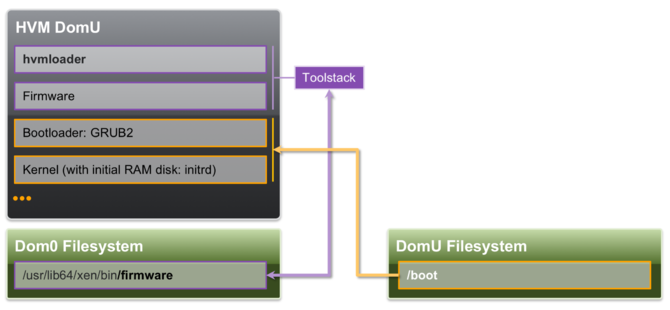Booting Overview: Difference between revisions
From Xen
Jump to navigationJump to search
Lars.kurth (talk | contribs) |
Lars.kurth (talk | contribs) |
||
| Line 13: | Line 13: | ||
However, behind the scenes |
However, behind the scenes |
||
* The [[hvmloader]] is copied into guest memory by Xen (under the control of the Toolstack). The [[hvmloader]] sets up all necessary information for the Device Emulator which emulates a HW environment that appears exactly like a physical machine. |
* The [[hvmloader]] is copied into guest memory by Xen (under the control of the Toolstack). The [[hvmloader]] sets up all necessary information for the Device Emulator which emulates a HW environment that appears exactly like a physical machine. |
||
* The correct firmware is automatically loaded as a binary blob (usually located in /usr/lib64/xen/boot) and copied into guest memory based on config settings, but can be overridden via the firmware config file option. |
* The correct firmware is automatically loaded as a binary blob (usually located in /usr/lib64/xen/boot) and copied into guest memory based on config settings, but can be overridden via the firmware config file option. See the various firmware options in the [https://xenbits.xen.org/docs/unstable/man/xl.cfg.5.html#HVM-guest-options man page]. |
||
== Direct Kernel Boot == |
== Direct Kernel Boot == |
||
Revision as of 16:18, 10 September 2018
This document describes the different mechanisms and config file options that are available for Xen.
The following diagram shows the first steps of the Linux boot and startup sequence to provide a baseline to allow explaining the differences
HVM Guest Boot Process
From a user's perspective the HVM Boot and install process is identical to the process on a native PC or server.
However, behind the scenes
- The hvmloader is copied into guest memory by Xen (under the control of the Toolstack). The hvmloader sets up all necessary information for the Device Emulator which emulates a HW environment that appears exactly like a physical machine.
- The correct firmware is automatically loaded as a binary blob (usually located in /usr/lib64/xen/boot) and copied into guest memory based on config settings, but can be overridden via the firmware config file option. See the various firmware options in the man page.


